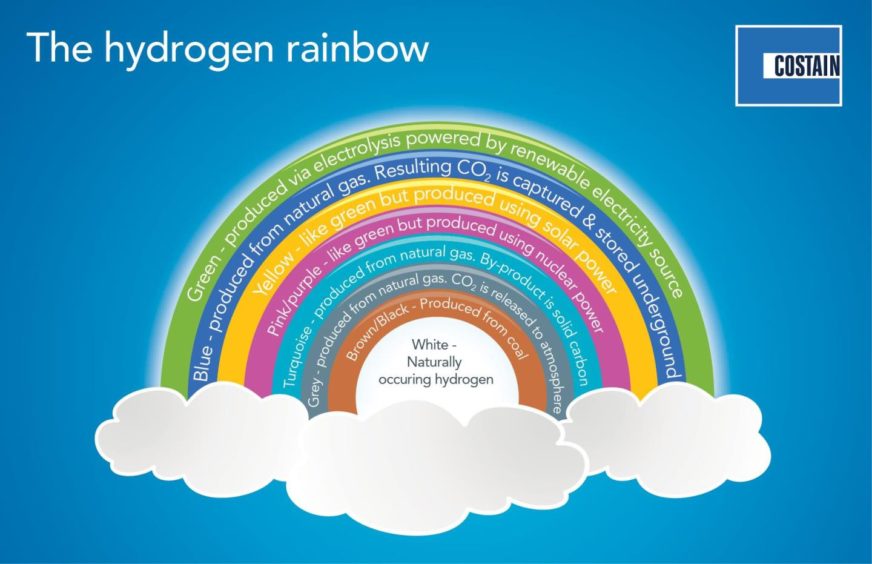
Unlike hydrocarbons, which produce carbon dioxide, heat and water when combusted in the presence of oxygen, hydrogen produces only heat and water. As we seek to decarbonise the UK’s energy sector one of the paths that is being explored is the use of hydrogen within a grid connected gas fired power plant in the UK.
The hydrogen colour spectrum
Although hydrogen is one of the most abundant elements, it does not occur naturally in an isolated state. The production of hydrogen has historically been associated with substantial carbon dioxide emissions, but following the growth in renewable power generation, this has changed, leading to a classification system of hydrogen based on its method of production:
(a) Green hydrogen production emits no harmful greenhouse gases by splitting water into its molecules using an electrolyser powered with electricity from renewable sources.
(b) Blue hydrogen (or ‘low carbon hydrogen’) is produced predominantly from natural gas through a process known as steam reforming, which combines natural gas and steam. The carbon dioxide which is produced as a by-product of this process is then captured and utilised or stored.
(c) Grey hydrogen is produced from natural gas using steam methane reformation. However, the carbon dioxide that is produced as a by-product of this process is not captured and stored.
(d) Black and brown hydrogen is at the opposite end of the carbon emission spectrum to green hydrogen and is the most environmentally damaging. It is produced through the gasification of brown coal.
(e) Pink hydrogen is created through electrolysis powered by nuclear energy.
(f) Emerald hydrogen is created using a process known as methane pyrolysis to produce hydrogen and solid carbon. If the thermal process is powered using renewable energy and the carbon is permanently stored or used, emerald hydrogen may be used as a form of low carbon emission hydrogen in the future.
(g) Yellow hydrogen is produced through electrolysis using solar power.
(h) White hydrogen is a naturally occurring geological hydrogen found in underground deposits and created through fracking. However, there are currently no strategies to exploit this hydrogen.
Current uses of hydrogen
Green hydrogen production is still in its infancy and 70% of the global production of hydrogen is currently grey, with blue hydrogen being viewed as an integral, transitional, step.
Many people see hydrogen, which can be used as fuel (producing power and heat) as well as a chemical feedstock, as a replacement for fossil fuels, particularly in heavy industry where high energy density is required. It has also been suggested that hydrogen can be used in the heavy transport sector where hydrogen fuel cells may be more economically feasible than electric batteries due to their greater power density.
However, hydrogen has so far not been used at scale due to the costs associated with its production.
Latest developments: hydrogen blending
Centrica Business Solutions has recently announced that it will commence a 12-month trial to burn hydrogen as a fuel at its 49MW gas peaking plant at Brigg in Lincolnshire. The hydrogen will be produced using pyrolysis which produces emerald hydrogen. Blending this low carbon hydrogen with natural gas will reduce the overall carbon intensity of the plant.
An added benefit is that the by-product of emerald hydrogen production is a form of solid carbon known as “carbon black”, which is used in the manufacture of tyres, rubbers and toners.
The outcome of this trial by Centrica will be important in informing future use cases of the technology needed to produce emerald hydrogen and the possibility of wider deployment across gas-fired thermal power plants.
Conrad Purcell is a partner in the Energy Practice Group in Haynes Boone’s London office.
Shu Shu Wong is an associate in the Energy, Power and Natural Resources Practice Group in the London office of Haynes and Boone.
Recommended for you


